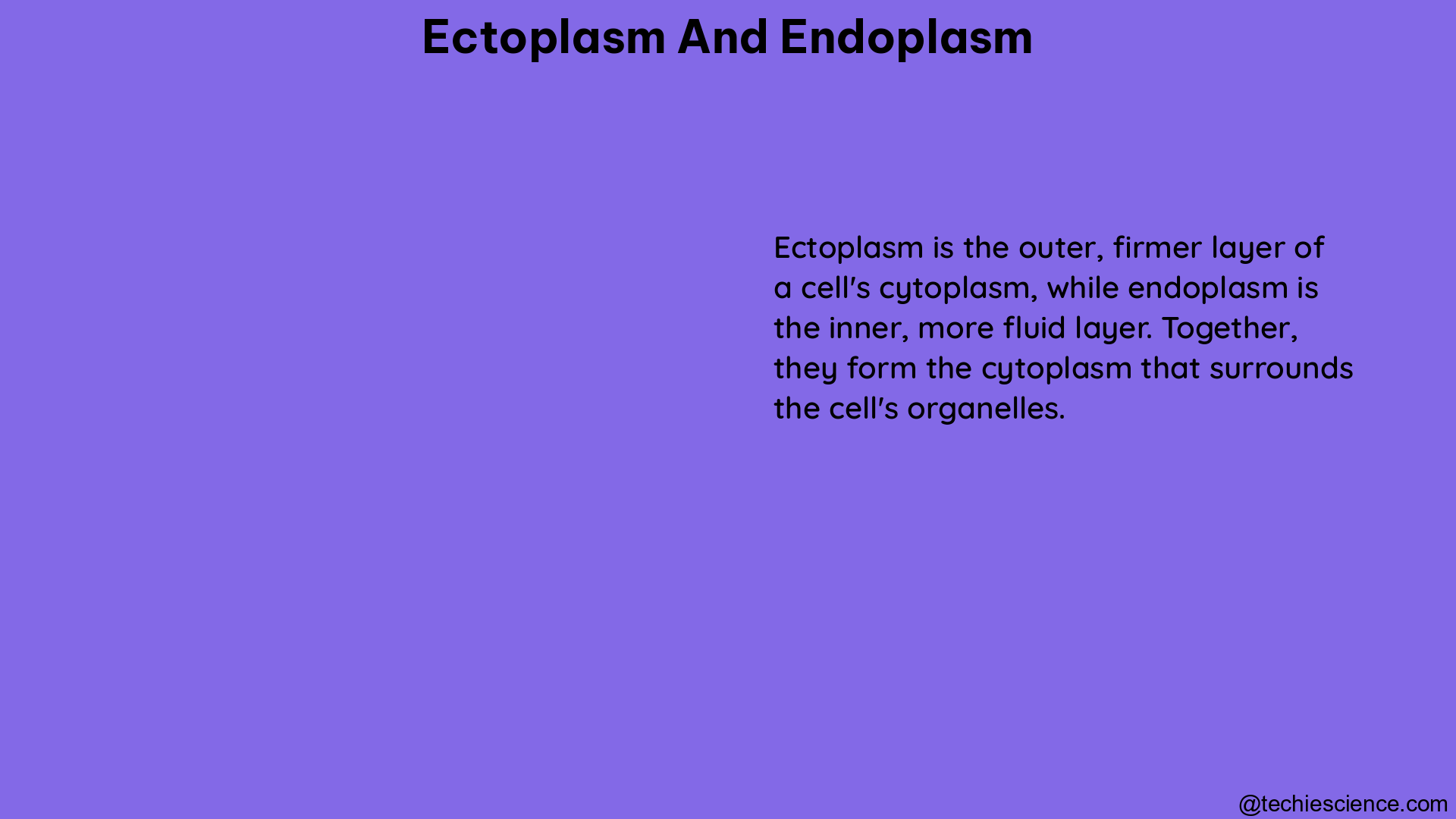Ectoplasm and endoplasm are two distinct regions within the cytoplasm of eukaryotic cells, each with unique structural and functional characteristics. The ectoplasm, located at the periphery of the cell, is responsible for cell movement and shape changes, while the endoplasm, surrounding the nucleus, is the site of most metabolic activities. Understanding the properties and roles of these cellular components is crucial for a comprehensive understanding of cellular biology.
Ectoplasm: The Outer Layer of the Cytoplasm
The ectoplasm, also known as the cell cortex, is the outermost layer of the cytoplasm, situated just beneath the cell membrane. This region is characterized by a dense network of cytoskeletal elements, including actin filaments and microtubules, which provide structural support and facilitate cell movement.
Structural Composition of Ectoplasm
-
Actin Filaments: The ectoplasm is rich in actin filaments, which form a dynamic network that can undergo rapid assembly and disassembly. These filaments are essential for cell motility, as they provide the contractile force necessary for cell movement and shape changes.
-
Microtubules: The ectoplasm also contains a network of microtubules, which serve as tracks for the transport of organelles and other cellular components. These structures play a crucial role in the organization and movement of the cell.
-
Contractile Proteins: The ectoplasm contains various contractile proteins, such as myosin, that interact with the actin filaments to generate the force required for cell movement and shape changes.
-
Regulatory Proteins: The ectoplasm is home to a variety of regulatory proteins that control the dynamics and organization of the cytoskeletal elements, ensuring the coordinated movement and shape changes of the cell.
Functional Roles of Ectoplasm
-
Cell Movement: The ectoplasm is primarily responsible for cell movement, as the dynamic rearrangement of its cytoskeletal elements, particularly the actin filaments, drives the cell’s locomotion.
-
Cell Shape Changes: The ectoplasm also plays a crucial role in the cell’s ability to change shape, which is essential for processes such as cell division, cell migration, and cell-cell interactions.
-
Cellular Signaling: The ectoplasm serves as a platform for various cellular signaling pathways, as it is the site of many receptor-mediated interactions and signal transduction events.
-
Organelle Positioning: The ectoplasm helps to maintain the spatial organization of the cell by providing a framework for the positioning and movement of organelles within the cytoplasm.
Endoplasm: The Inner Cytoplasm Surrounding the Nucleus

The endoplasm, also known as the inner cytoplasm, is the region of the cytoplasm that surrounds the cell nucleus. This area is characterized by a higher concentration of organelles and metabolic activities compared to the ectoplasm.
Structural Composition of Endoplasm
-
Organelles: The endoplasm is densely packed with various organelles, including mitochondria, endoplasmic reticulum, Golgi apparatus, and ribosomes, which are responsible for the cell’s metabolic processes.
-
Cytoskeletal Elements: While the ectoplasm is the primary site of cytoskeletal organization, the endoplasm also contains a network of microtubules and intermediate filaments that contribute to the overall structural integrity of the cell.
-
Cytosol: The endoplasm is filled with the cytosol, the fluid-like medium that surrounds the organelles and provides the necessary environment for various biochemical reactions.
Functional Roles of Endoplasm
-
Metabolic Activities: The endoplasm is the primary site of the cell’s metabolic activities, including protein synthesis, lipid metabolism, and energy production through processes such as cellular respiration and ATP synthesis.
-
Organelle Positioning and Transport: The endoplasm plays a crucial role in the positioning and movement of organelles within the cell, ensuring the efficient distribution of cellular components and the coordination of various metabolic processes.
-
Cellular Signaling: While the ectoplasm is the primary site of cellular signaling, the endoplasm also contributes to signal transduction pathways, particularly those involving the endoplasmic reticulum and Golgi apparatus.
-
Nucleus-Cytoplasm Interactions: The endoplasm facilitates the exchange of information and materials between the nucleus and the rest of the cell, ensuring the coordinated regulation of cellular processes.
Quantifying Ectoplasm and Endoplasm
Researchers have developed various experimental techniques to quantify the properties and characteristics of ectoplasm and endoplasm, providing valuable insights into their roles in cellular function.
Differential Centrifugation
Differential centrifugation is a widely used technique for the separation and quantification of cellular components, including ectoplasm and endoplasm. By subjecting a cell homogenate to a series of centrifugation steps at different speeds, researchers can isolate and measure the volume, density, and protein content of the ectoplasm and endoplasm fractions.
Electron Microscopy
Electron microscopy, particularly transmission electron microscopy (TEM), allows for the high-resolution imaging and quantification of the structural features of ectoplasm and endoplasm. Researchers can use TEM to measure the thickness, organization, and distribution of cytoskeletal elements within the ectoplasm, as well as the size, number, and distribution of organelles in the endoplasm.
Cell Movement and Shape Analysis
By tracking the movement and shape changes of cells, researchers can infer the properties and dynamics of the ectoplasm. Techniques such as time-lapse microscopy and cell tracking software can be used to measure parameters like cell speed, directionality, and deformability, which are directly related to the organization and function of the ectoplasm.
Biochemical Assays
Biochemical assays can be used to quantify the specific components and activities of ectoplasm and endoplasm. For example, researchers can measure the concentration and activity of actin, myosin, and other cytoskeletal proteins in the ectoplasm, or the activity of metabolic enzymes and the levels of ATP and other energy-related molecules in the endoplasm.
By combining these various experimental techniques, researchers can obtain a comprehensive understanding of the structural, functional, and dynamic properties of ectoplasm and endoplasm, and how they contribute to the overall functioning of the cell.
Conclusion
Ectoplasm and endoplasm are two distinct regions within the cytoplasm of eukaryotic cells, each with unique structural and functional characteristics. The ectoplasm, located at the cell periphery, is responsible for cell movement and shape changes, while the endoplasm, surrounding the nucleus, is the site of most metabolic activities. Understanding the properties and roles of these cellular components is crucial for a comprehensive understanding of cellular biology, and researchers have developed a variety of experimental techniques to quantify their characteristics and dynamics.
References:
- Alberts, B., Johnson, A., Lewis, J., Raff, M., Roberts, K., & Walter, P. (2002). Molecular Biology of the Cell. Garland Science.
- Bray, D. (2001). Cell Movements: From Molecules to Motility. Garland Science.
- Lodish, H., Berk, A., Zipursky, S. L., Matsudaira, P., Baltimore, D., & Darnell, J. (2000). Molecular Cell Biology. W. H. Freeman.
- Pollard, T. D., & Earnshaw, W. C. (2007). Cell Biology. Saunders.
- Voet, D., & Voet, J. G. (2011). Biochemistry. Wiley.

Hi…I am Sadiqua Noor, done Postgraduation in Biotechnology, my area of interest is molecular biology and genetics, apart from these I have a keen interest in scientific article writing in simpler words so that the people from non-science backgrounds can also understand the beauty and gifts of science. I have 5 years of experience as a tutor.
Let’s connect through LinkedIn-